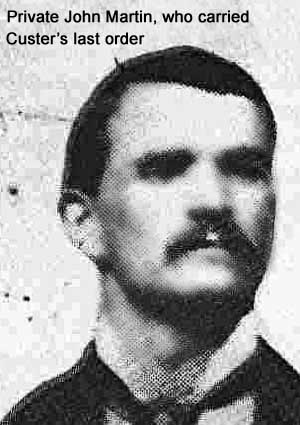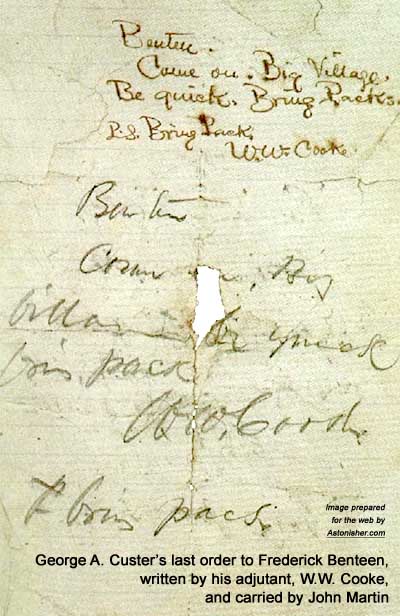|
|||||||
Bruce Brown's 100 Voices... John Martin's Story of the Battle, #2
THE STORY OF TRUMPETER JOHN MARTIN
I kept on up the north and south coulee and soon met a mounted man whom I recognized as one of C troop, but whose name I did not know. He inquired where the command was, and I told him down the coulee quite a distance and that he had better fall back to the pack train, as he would likely be cut off by the Indians before reaching the command, but he kept on. After this I met Boston Custer8 and went on to Benteen. As Benteen approached the rivers we turned to the north along the bluffs just above the river and there met three Crow scouts who pointed out Reno's men who were now retreating across the bottom. [Note: these were White Man Runs Him, Goes Ahead and Hairy Mocassin.] It has been asserted by some writers of late years that Custer's command never got nearer the river than where he was found dead, but I know this to be incorrect for I myself was with General Custer when he was much nearer the river than is the point where he was found dead and I saw him and his command right down on the flat within a few hundred yards of the river, retreating from it. Until late years no one ever seemed to doubt the fact that Custer went to the river at the place which I state.
In Benteen's charge the Indians had formed in the gully and were coming up the hill. We charged out, old Benteen right in front of us. Before this charge the Indians had been close enough to throw stones into our lines. When we charged out we killed three of them. The Indian who was killed and whom the other Indians could not getaway was killed on evening of June 25. I showed (on June 27) Benteen where I left with note from Custer, and Benteen estimated the distance to be 600 yards to Ford B. Did not go down there with Terry on June 27.10 Reno introduced me to Terry when Terry came up and [Reno] said:" Gen. Terry, here is the man who carried the last message from Custer." Terry then asked me several questions as to how far I had been with Custer, etc. and then said: "Well, you are a lucky man and I wish you good fortune." In the village I saw the two tepees with dead Indians in them and only about 100 yards away on the river bank there was a pile of dead Indians under a tree with blankets thrown over them.... Saw body of white man in village where Knipe [Daniel Kanipe, the other messenger who carried Custer's last order in verbal form] showed me but says body was in a tepee. Walter Mason Camp's Notes: 1. Camp MSS, field notes, John Martin, folder 3, Lilly Library. 2. Martin says whole column passed over the high ridge from which they could plainly see village and children and dogs in it. Martin says he was with Custer after he passed the high ground and left him just as the command started down a ravine to get off the bluff, somewhat to the right of highest ground and about 1000 feet from it. (Camp MSS, field notes, Custer's Trail at Little Bighorn, box 2, folder 6, Lilly Library.) 3. In his notes Walter Camp often used the term Dry Creek to describe Medicine Tail Coulee. 4. Martin was seemingly confused at this point. In another note Camp says of Martin, "When started out with message had not seen village from this coulee." (Camp MSS, field notes, John Martin, folder 3, Lilly Library.) 5. Martin said Cooke told him to follow back on same trail and after he had gone 500 or 600 yards or perhaps s/ mile, I got on same ridge from which Genl. Custer saw the village the first time and on looking down on the bottom I saw Major Reno and his command engaged already, but I did not pay any attention to that. Thinks that from time he saw Reno he was 15 or 20 minutes getting up to Benteen. (Camp MSS field notes, Custer's Trail at Little Bighorn, folder 6, Lilly Library.) 6. Thinks he left Custer 2 miles north of Reno Hill. After he left Custer he traveled up hill for some distance. (Ibid.) 7. Met Boston Custer half way between medium coulee and Weir Hill. Boston asked me where Custer was and if he had been attacked and I said no. Soon after... met the two men. After this I heard a volley and looked back and saw Custer retreating back from the river. (Camp MSS, field notes, John Martin, folder 3, Lilly Library.) 8. On his way to Benteen with the message he met first Boston Custer on the bluffs and farther along on the bluffs two enlisted men who were together and inquired for Custer's command. This is another good proof that Custer hesitated and stopped some considerable time after he came in sight of village. (Camp MSS, field notes, unclassified envelope 130, Lilly Library.) About meeting Boston Custer, when going back with message and after, he heard firing. Told him he had better look out as there were Indians around and Boston Custer said: "Well I am going to join the command anyhow. .." It would seem that if the meeting of Boston Custer was a fact Custer must have remained some time in vicinity of ford or else Boston Custer must have cut a big circuit and joined command on the high ground. However, it might have been Reno's firing that Martin heard, in which case Boston Custer may have had time to overtake the General before reaching Ford B. The meeting of Boston Custer and the fact that he died with the General can hardly be reconciled by any other explanation. (Camp MSS, field notes, John Martin, folder 3, Lilly Library.) 9. Martin says that Benteen followed Custer's trail (Important): We marched on Gen. Custer's trail and when we got up this ridge from where I saw Maj. Reno fighting on the bottom we saw Maj. Reno's command and the Major himself, the men still retreating on the bluff. (Ask Knipe how far he found McDougall back of Benteen and whether he remembers Martin's coming back to McDougall). Martin says his own company was with Benteen. He says packs got up to Reno in 10 or 15 minutes behind Benteen, and in another place he says 3 hours. Says it was 1 %2 hours after McDougall reached Reno Hill before the whole command went in direction of Custer. Says he found Benteen 3 or 4 miles from where he left Custer. (Camp MSS, field notes, Custer's Trail at Little Bighorn, folder 6, Lilly Library.) 10. Again some confusion in Martin's statements, since in another note Camp quotes Martin: On June 27 I accompanied General Terry over all this ground and explained these matters to him in detail. (Camp MSS, field notes, John Martin, folder 3, Lilly Library.) Custer in '76: Walter Camp's Notes on the Custer Fight, edited by Kenneth Hammer, Brigham Young University Press 1976 p 103 - 105
As the Battle of the Little Bighorn was rushing to climax, Col. George A. Custer sent the same message to Capt. Frederick Benteen, his best battlefield commander, and Capt. Thomas McDougall, who commanded the Seventh Cavalry's extra ammunition packs, via two different couriers. With Trumpeter Giovanni Martini [AKA John Martin] he sent Benteen the famous "come on. big village" note penned by Lt. W.W. Cooke, the regimental adjutant. [Martin's note was written because his command of English was sketchy. Here is Charles Windolf's description of Martin and Kanipe.] And a few minutes earlier, he sent the same message in verbal form to McDougall and Benteen via Sgt. Daniel Kanipe. Both Martini and Kanipe got through, and as a result both survived the battle. Here is Benteen's account of receiving Martin's message, plus an image of the original in the hand of Lt. W.W. Cooke. Martin and Kanipe are frequently described as the "last Seventh Cavalry troopers to see Custer alive" (or words to this effect) because they carried Custer's last order to Benteen, and thus were the last men to get out alive that day. But actually, the "last Seventh Cavalry trooper to see Custer alive" was not John Martin or Dan Kanipe. According to the eye-witness record, it was Peter Thompson. Medal of Honor-winner Thompson's horse gave out just before the battle, and while he was trying to rejoin Reno, Thompson caught a glimpse of Custer at the river, away from his command and in the midst of some kinky business with a tethered squaw, something that American historians have not wanted to talk about for over 100 years. See Peter Thompson's account of the battle and Who Killed Custer -- The Eye-Witness Answer for more info. * * * Here's Charles Windolf's description of meeting Martin on the trail that afternoon... "We hadn't gone on very much farther before we saw a second figure in uniform riding towards us. He was Trumpeter Martini [Giovanni Martini, or John Martin] of my company, who had been assigned that morning as special orderly trumpeter to General Custer. I learned afterwards that he had a message from Custer to Benteen, that had been scribbled out on a field order pad and signed by Lieutenant Cooke the Adjutant. It read: "Benteen, come on. Big village. Be quick. Bring packs. P. S. Bring pack, W. W. Cooke." "Martini was a salty little Italian who had been a drummer boy with Garibaldi in the fight for Italian independence. Captain Keogh, an Irishman commanding Troop "I," who was riding this day with Custer, had also fought with Garibaldi. "I knew Martini very well because he belonged to H. We used to tease him a lot but we never did after this fight. He proved that he was plenty man. His horse was spouting blood from a bullet wound in his right hip but Martini didn't know anything about it. Benteen ordered him to rejoin his company. I always figured that Benteen thought that since Sergeant Kanipe had already taken word back to Captain McDougall to bring on the pack train as fast as they could come, there was no use sending more word to him. Anyway, Martini's horse was played out and it was all that he could do to keep up with us." * * * Here is another account of the battle by John Martin. -- Bruce Brown |
|||||||




 CUSTER FIRST halted on Weir's hill and took a look at village (from this point he could see only about 1/3 of it - Hunk and Blackfoot villages - WMC).
CUSTER FIRST halted on Weir's hill and took a look at village (from this point he could see only about 1/3 of it - Hunk and Blackfoot villages - WMC). When Benteen met Reno on hill, Reno requested him to halt his command, etc. Benteen pulled out Cooke's note and showed it to Reno. Reno was bareheaded and much excited and exclaimed: "Well I have lost about half of my men, and I could do no better than I have done."
When Benteen met Reno on hill, Reno requested him to halt his command, etc. Benteen pulled out Cooke's note and showed it to Reno. Reno was bareheaded and much excited and exclaimed: "Well I have lost about half of my men, and I could do no better than I have done."







